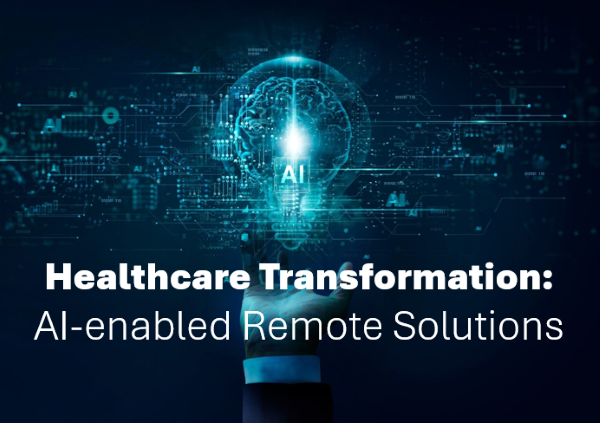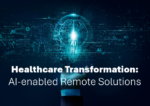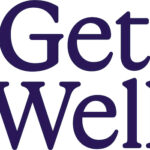Remote healthcare has quickly evolved from an idea in the minds of providers to the new standard defining modern healthcare. Patient monitoring has experienced a journey that is redefining flexibility, granting patients more freedom, and allowing for a new level of care previously unattainable.
Basic monitoring has humble beginnings – from manual pulse checks and visual inspections to digital monitors, ECGs, and electronic glucose monitoring. Now we stand at the brink of a new era: fully remote monitoring. GenAI, telemedicine, wearable tech, and cutting-edge solutions are increasingly meeting evolving needs at every stage of healthcare service. Future-focused healthcare leaders are recognizing these possibilities and implementing them properly with an eye on managing the risks.
Expanded access through flexible remote care
One of the most promising aspects of remote healthcare is its diversity of application. Receiving care at home is a primary use that comes to mind, but the reach of remote solutions extends far beyond. Patients in hospitals or other treatment facilities can now access specialized care that is locally unavailable without remote technologies. Teledoc, Amwell, and similar telehealth platforms provide 24/7 patient access to healthcare professionals, enabling consultations, diagnoses, and prescriptions without the need for physical visits.
Most are aware of the basic health benefits of smartwatches and fitness trackers such as heart rate monitoring, step counting, but the uses of devices like Apple Watches and Fitbits don’t stop there. Many models can monitor vital signs, oxygen saturation, and provide electrocardiogram (ECG) readings. Alerts can be programmed to notify both the patient and healthcare provider to respond to potential issues in real time for delivering the peace of mind of continuous care.
Filling coverage gaps to overcome care delivery challenges
The convergence of technology and healthcare is particularly timely given the World Health Organization’s forecast of a 10 million shortfall in health workers by 2030. Traditional healthcare delivery models, which usually require both parties to be on-site, are reaching a breaking point. Remote care technologies are alleviating these pressures by optimizing the time and resources of healthcare professionals, reducing patient wait times, and broadening access to essential services.
Remote patient monitoring systems (RPMs) are at the forefront of these changes, and are being integrated into healthcare workflows, enabling continuous observation of patients with chronic conditions. Companies like Philips and Medtronic offer RPM platforms that collect data from patients’ homes, analyze it using AI algorithms, and send alerts to clinicians if any abnormalities are detected. This proactive approach not only improves patient outcomes but also reduces hospital readmissions, freeing up resources for other critical cases.
GenAI and AI provide game-changing patient outcomes
GenAI/AI is revolutionizing healthcare in ways once thought impossible. Its applications range from routine tasks such as temperature measurement using contactless thermometers, to more complex procedures such as AI-guided robotic surgery. Contactless pulse oximeters monitor oxygen saturation, take electrocardiograms, work as stethoscopes, and enable remote management to increase or manage oxygen levels for patients, offering vital support without physical presence.
Beyond basic monitoring, AI is making strides in diagnostics and treatment planning. IBM Watson Health is using AI to analyze vast amounts of medical data, helping doctors to make more accurate diagnoses and develop personalized treatment plans. AI-driven analytics are also being used to predict patient outcomes and tailor treatments, while advanced remote consultation tools, such InTouch Health’s telepresence robot Vici, are enhancing the patient-provider connection.
Generative AI, famous for revolutionizing coding, customer support, and writing tasks, also has an important hand in bringing remote care to a new age. Detailed care plans and monitoring summaries, which needed to be painstakingly compiled in yesteryear, can now be crafted by GenAI, giving providers and patients almost instant access to vital information.
These technologies are particularly valuable in remote areas, where access to specialized care is limited. Patients can trade long and expensive travel for an app to access care and consultation services.
The applications even extend to highly specialized care, such as surgery assistance. Robotic surgery via augmented or virtual reality allows for specialized remote surgeons to assist on-site surgeons with procedures. This grants patients access to specialized care they might not have otherwise been provided. AI-guided robotic surgery can also carry out some procedures, achieving unprecedented precision.
AI and IoT: the backbone of modern healthcare
The integration of AI with the Internet of Things (IoT) is a key driver of this healthcare transformation. Real-time data collection and sharing across multiple systems enable continuous patient monitoring and rapid response to changing health conditions. Predictive analytics and case-trained AI models offer dynamic care management, which is essential in a field where timely intervention can be life-saving.
Smart hospitals are a prime example of this integration. Equipped with IoT devices, these hospitals use AI to manage everything from patient flow to energy consumption. GE Healthcare’s Command Centers, for example, leverage AI and IoT to monitor patient data, predict potential issues, and optimize resource allocation. This not only improves patient care but also enhances the efficiency of healthcare operations.
The key to safe and sustainable implementation
Alongside the praise that AI receives are misgivings regarding its data security. This reaches a new level when patient data is concerned. Patient data must be safeguarded with the highest standards of confidentiality, ensuring compliance with regulations such as the General Data Protection Regulation (GDPR) and the Health Insurance Portability and Accountability Act (HIPAA). Furthermore, healthcare providers must be thoroughly trained to use these systems, with robust failsafe mechanisms and stable network infrastructures in place to prevent potentially life-threatening failures.
Blockchain technology is emerging as a possible solution to these security challenges. By creating decentralized and immutable records of patient data, blockchain can ensure data integrity and prevent unauthorized access. Companies like Guardtime are already deploying blockchain-based solutions to secure healthcare data, offering an additional layer of protection for sensitive information. Regardless of what new systems are utilized, a boundary needs to be established between what can be safely and effectively implemented; each provider must assess which programs make sense for their specific uses.
The key to granting patients more freedom can be found in AI and GenAI innovations
Bridging physical distances through Gen AI/AI-driven remote healthcare solutions can grant patients greater freedom while improving healthcare outcomes. Without the need to be consistently present in a healthcare facility, chronically ill patients can receive quality monitoring and care in a place that is most comfortable for them. Healthcare professionals can maximize their time and impact by taking advantage of top-of-the-line AI assistants and data-driven guidance. GenAI/AI is interwoven with the medical world’s future, and taking advantage of it now can lead to better care, faster.







